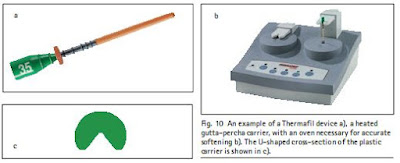Several manufacturers now supply these devices, illustrated in Figure 10. Alpha-phase gutta-percha is attached to a rigid carrier, in a variation of the technique originally described by Johnson in 1978.
 Most carriers are now plastic. The excess material is removed, and the carrier remains in the canal as a central core. The softened gutta-percha flows well in to canal aberrations, fins, etc., giving very good threedimensional obturation.
Most carriers are now plastic. The excess material is removed, and the carrier remains in the canal as a central core. The softened gutta-percha flows well in to canal aberrations, fins, etc., giving very good threedimensional obturation.
Success depends, as with all techniques, upon thorough canal cleaning and shaping. The carriers have a 4% taper, and an underprepared canal will be difficult if not impossible to obturate to working length with these devices. A range of sizes is presented, and most systems employ a method of ensuring the fit of the device before obturation is commenced. This may either be a blank carrier with no gutta-percha attached, or preferably a file of the same dimensions as the carrier. The apical preparation may then be refined to ensure an accurate fit of the device.
The canal should be cleaned and dried, and a very fine coating of sealer applied to the canal orifice only. Excess sealer may be extruded under hydraulic pressure through the apical foramen, with resultant pain and inflammation. In the
Fig. 10 An example of a Thermafil device a), a heated gutta-percha carrier, with an oven necessary for accurate softening b). The U-shaped cross-section of the plastic carrier is shown in c).
meantime the rubber stop on the selected device is set to working length, and the device placed in a special oven to soften the gutta-percha. When ready, the device should be swiftly and smoothly inserted to working length, and held in place for a few seconds. Using a high-speed bur the excess carrier may be sectioned and removed from the canal orifice, and a plugger used to compact the gutta-percha in this area. A layer of resin-modified glass ionomer completes the obturation.

Success depends, as with all techniques, upon thorough canal cleaning and shaping. The carriers have a 4% taper, and an underprepared canal will be difficult if not impossible to obturate to working length with these devices. A range of sizes is presented, and most systems employ a method of ensuring the fit of the device before obturation is commenced. This may either be a blank carrier with no gutta-percha attached, or preferably a file of the same dimensions as the carrier. The apical preparation may then be refined to ensure an accurate fit of the device.
The canal should be cleaned and dried, and a very fine coating of sealer applied to the canal orifice only. Excess sealer may be extruded under hydraulic pressure through the apical foramen, with resultant pain and inflammation. In the
Fig. 10 An example of a Thermafil device a), a heated gutta-percha carrier, with an oven necessary for accurate softening b). The U-shaped cross-section of the plastic carrier is shown in c).
meantime the rubber stop on the selected device is set to working length, and the device placed in a special oven to soften the gutta-percha. When ready, the device should be swiftly and smoothly inserted to working length, and held in place for a few seconds. Using a high-speed bur the excess carrier may be sectioned and removed from the canal orifice, and a plugger used to compact the gutta-percha in this area. A layer of resin-modified glass ionomer completes the obturation.
Some carriers are manufactured with a U-shaped cross-section to facilitate removal with a drill should retreatment be necessary. However, although it may be possible to drill out the carrier, this technique may not be appropriate if a post and core may be indicated in the future.